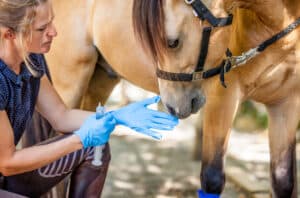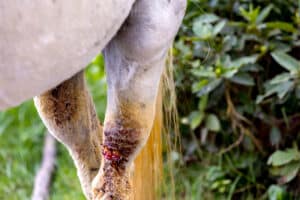First Aid Essentials
Be prepared! It’s a great motto to live by. Dr Clare Williams-Paterson of Apiam Equine Services gives some expert advice on what should be in an equine first aid kit, and what to prepare for.
Putting together a well-organised equine first aid kit is a great investment. These kits provide a ready and waiting tool, and should be made easily accessible to manage a frontline crisis – be it at home, during travel, or at an equestrian event.
Let’s face it, emergencies are part and parcel of owning a horse. They can happen at any time of day or in the dark of night, can be very random, and can involve any body system. Commonly, these emergencies range from lacerations, puncture wounds and broken bones, to colic, choke and eye injuries – to name just a few.
We all know that a horse’s favourite pastime is plotting how they can best cause their owner maximum stress at the most inconvenient moment, and being well prepared can help defuse the panic and stress associated with these often highly emotionally charged situations, while contributing significantly to your horse’s welfare, both during and after the crisis.
Once you have your basic kit together, maximise this preparedness initiative by taking the time to learn basic equine first aid skills. It also pays to be observant and understand what the baseline normal is for your horse.

Your equine first aid kit should include Latex gloves.
What’s in the kit?
Be sure to select an easy to carry bag. Think practical and simple – you can always improvise and improve. For example, a first aid kit that’s stored in the barn at home has the scope to include more than say a backpack that you might carry during a bush ride – and this may vary again for the kit that is carried in the car or horse float to an event.
Physical Exam Tools:
- Digital thermometer
- Stethoscope
- Halter and lead rope
- Latex gloves
- A twitch
- Torch or headlight
- Hoof pick
- Hoof knife
- A couple of clean towels
Bandage Material:
- Pack 10cm x 10cm gauze swabs
- Roll of cotton wool
- Roll of cotton gauze (e.g. Gamgee)
- Non-stick gauze pads (e.g. Melolin)
- Non-adhesive wrap (e.g. Vetrap)
- Adhesive wrap (e.g. Elastoplast)
- A poultice (e.g. Animalintex)
- Duct tape
- Blunt tipped bandage scissors
Wound Care:
- Packs of saline solution for cleaning wounds/rinsing eyes
- Dilute iodine solution (e.g. Betadine) or chlorhexidine for cleaning wounds
- Bottle of artificial tears lubricant
- Fly repellent
Other: Wire-cutters and pliers (horses are experts at getting tangled up in wire fencing), baling twine/hay string, and cable ties
Emergency phone numbers:
These days, most of us store numbers in our smartphones, but it pays to have a list in your kit in preparation for the worst case situations where your phone is damaged, lost, or has a flat battery, or you are incapacitated and unable to operate the kit and/or phone.
Back up emergency items: Fresh or open wounds involving a limb are a common case scenario. Obviously, it is critical to stop any bleeding and this is usually achieved by applying pressure. However, on the lower leg there is insufficient tissue to protect tendons and skin from this pressure, so appropriate padding is essential to prevent more damage.

And be prepared to think outside the square in an emergency. The polo wrap used to support tendons and ligaments from brushing and interference during work can double as an effective first aid bandage. For padding, cotton sheets or pillow covers cut into strips can serve you well, and individually wrapped sanitary pads are both sterile and inexpensive. Thick or thin and cut to size, these can make effective wound dressings. Also, never underestimate the absorbability and padding value of the disposable nappy!
Important to remember is that there is such a thing as over-cleaning wounds. Overly aggressive scrubbing can slow down blood clotting and make things dramatically worse. Application of irritant substances may also adversely affect local tissue and/or deeper structures such as bones. In the case of many wounds, less is more – remove gross contamination and cover appropriately, even simply with protective gauze or gauze moistened with sterile saline solution and wait for your veterinarian’s expert assessment.
Vital information
Taking your horses’ vital signs (temperature, heart rate and respiratory rate) provides invaluable information. But a note of warning here, only perform these checks if it is safe to do so. Horses are big, strong, fight or flight animals and when in pain they are usually not themselves and may not respect your personal space. Sometimes it is safer to wait for help.
In many instances, vital sign numbers relayed at the time of calling your veterinarian can be helpful in assisting them to gauge the severity of the situation, and occasionally, whether any medication should be administered before their arrival. However, for these numbers to be of real value, you need to know your horse’s normal numbers. A normal temperature for an adult horse is 37.2-38.3°C; a normal heart rate is 28-44 beats per minute (which is approximately half that of ours); and a normal respiratory rate is 10-24 breaths per minute (a rate similar to ours).
Aside from respiratory rate, you can’t guess the numbers just by ‘eyeballing’ the horse. For example, a horse may not be obviously sweating but could still have an inappropriately elevated temperature. So, you must measure their temperature with a thermometer, and this brings us to how to take an accurate temperature reading! The digital thermometer should remain inserted in the horse’s rectum for the full length of time required (this varies between thermometers) – wait for the beep before removal.
Your horse’s respiratory rate is easy to calculate. Simply count the number of breaths they take in one minute while watching the flank or nostril. To check their heart rate, feel for the pulse in the artery on the inside of their jawbone. When time is of the essence, count the number of beats over 15 seconds, multiply that number by four and this will give you the resting heart rate. Alternatively, a stethoscope can be used to listen to the heart rate on the left side of the horse’s chest (over the ribs and just behind the elbow). Palpating the pulse and listening through a stethoscope at the same time can help make sure that you are not double counting heart sounds. Because of the great variability among different breeds and classes of horses, it is wise for owners to make a point of knowing their horse’s normal heart rate.
Ideally, in case of your horse becoming colicy, you should also be familiar with normal gut sounds. You want to hear sounds of movement; there should be gurgles in an area and then similar sounds a bit further down the line. Silence is abnormal as are over the top ‘laundry sounds’ that may indicate overactive bowels.
To get a good perspective on normal, use a stethoscope and practice listening to regular gut sounds across both sides of the abdomen while your horse is healthy.
It is also important to know what else equates to normal for your horse; their usual appetite, water intake, urine and manure output, and their day to day behaviour and activities.

Be prepared to think outside the square in an emergency – for example, a polo wrap can double as an effective first aid bandage.
Prescription medications
Horses experiencing colic (abdominal pain) and eye injuries are common situations where medications have sometimes been inappropriately administered prior to veterinary arrival and assessment.
It is highly recommended to refrain from medicating your horse until directed to do so by your veterinarian. The last thing you, your horse, or your vet need in an emergency is a delay in achieving a diagnosis and treatment plan due to the potential masking effects of certain medications, or to inappropriate dosing.
Whilst the full scope of equine emergencies and their management is not possible to cover here, remember that common things are common. For first line basics, keep it simple, stay safe, and as much as possible, be prepared – then you can be confident that in a crisis you can offer the very best help possible.
Visit Apiam Animal Health to learn more about their range of services.



